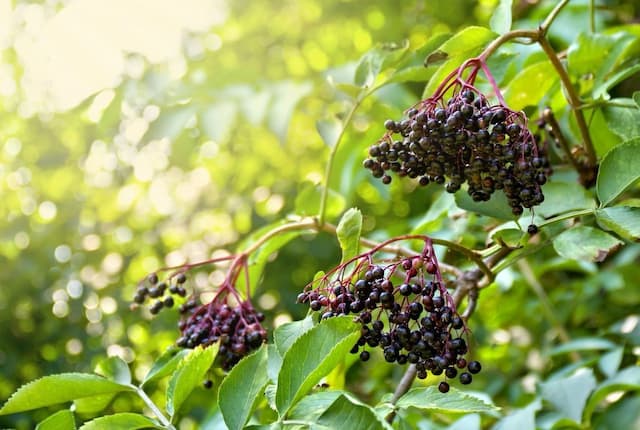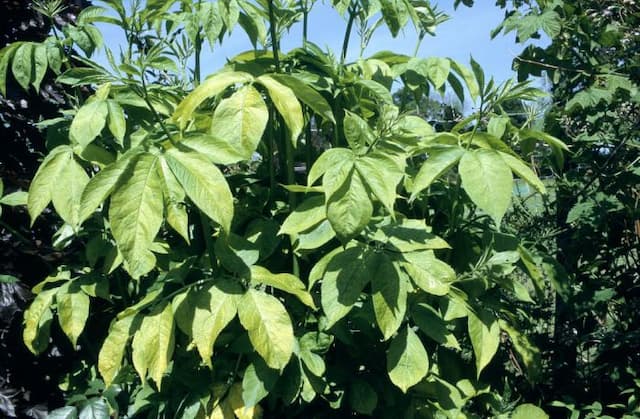Doublefile Viburnum Viburnum plicatum f. tomentosum 'Dart's Red Robin'

ABOUT
The plant known commonly as 'Dart's Red Robin' is recognized for its distinctive layered horizontal branches that create a structured, yet graceful silhouette. During the spring season, it bursts forth with a proliferation of lacecap flowers that are predominantly white with subtle hints of dusty rose, making for an eye-catching floral display. As the plant matures through the seasons, its leaves present a vivid show of color transformation. The foliage starts as a fresh green tint and gradually transitions to deep red tones, signifying the arrival of autumn. The leaves are broad with a pleated or puckered texture, enhancing the tactile appeal of the shrub. To complement the vivid foliage, the plant also bears red fruit that stands out against the backdrop of the changing leaves, inviting a variety of birds and adding to the plant's ornamental appeal.
About this plant
 Names
NamesFamily
Adoxaceae.
Synonyms
Japanese Snowball, Doublefile Viburnum, Mariesii.
Common names
Viburnum plicatum var. tomentosum 'Dart's Red Robin'
 Toxicity
ToxicityTo humans
Doublefile viburnum is generally not considered toxic to humans. However, it's always possible for some individuals to have a sensitivity or allergic reaction to any plant, so it's advisable not to ingest parts of this or any ornamental plant. Ingestion typically does not result in serious poisoning. In the rare cases where gastrointestinal discomfort may occur after ingestion, symptoms could include nausea, vomiting, or diarrhea.
To pets
Doublefile viburnum is also not known to be toxic to pets. As with humans, ingestion of plant material can sometimes lead to gastrointestinal upset such as vomiting or diarrhea, particularly if the pet is not used to eating such material or has a sensitive stomach. However, serious toxicity from consuming doublefile viburnum is not common, and it is generally considered a plant with low risk of poisoning to pets.
 Characteristics
CharacteristicsLife cycle
Perennials
Foliage type
Deciduous
Color of leaves
Green
Flower color
White
Height
8-10 feet (2.4-3 meters)
Spread
6-8 feet (1.8-2.4 meters)
Plant type
Shrub
Hardiness zones
5-8
Native area
Japan China
Benefits
 General Benefits
General Benefits- Ornamental Appeal: Doublefile Viburnum boasts attractive, layered horizontal branches and abundant lacecap white spring flowers, which are visually striking in any landscape.
- Year-round Interest: This plant features bright red to dark purple berries in the late summer, and its leaves turn a vibrant red in the fall, providing seasonal interest.
- Wildlife Habitat: The berries produced by Doublefile Viburnum are a valuable food source for birds, while the dense foliage offers nesting sites and shelter.
- Ease of Care: Doublefile Viburnum is known for being low-maintenance, requiring minimal pruning and care once established.
- Privacy Screen: With its dense growing habit, it can be used as an informal hedge or screen, providing privacy to a yard or garden area.
- Tolerance: It is generally tolerant of various soil types and can withstand different environmental conditions once established.
 Medical Properties
Medical PropertiesThis plant is not used for medical purposes.
 Air-purifying Qualities
Air-purifying QualitiesThis plant is not specifically known for air purifying qualities.
 Other Uses
Other Uses- The Doublefile Viburnum can be cultivated as a natural fence when planted in a row. Its dense foliage provides privacy throughout the growing season.
- With its layered branches, the Doublefile Viburnum serves as an excellent supportive structure for garden lighting, creating a soft, diffused light effect.
- The strong branches of the Doublefile Viburnum can be used in the art of Ikebana, the Japanese art of flower arrangement, providing a sturdy foundation for the design.
- Its leaves can be used as a natural dye for fabrics, giving them a range of green hues when properly prepared.
- Insects, particularly butterflies, are attracted to the Doublefile Viburnum's flowers, so it can be used as a feature plant to promote pollinator activity in gardens.
- The dense branching pattern provides ideal nesting sites for birds, making the plant a haven for avian wildlife in a garden setting.
- During autumn, the berries can be used for crafting decorative wreaths and other seasonal ornaments.
- When dried, the flowers and berries can be integrated into potpourri mixes for a subtle, floral fragrance.
- The Doublefile Viburnum can be planted to prevent soil erosion on slopes due to its extensive root system.
- Its ornamental appeal throughout multiple seasons, including striking autumn foliage, makes it an excellent candidate for themed gardens, such as a four-season garden.
Interesting Facts
 Feng Shui
Feng ShuiThe Doublefile Viburnum is not used in Feng Shui practice.
 Zodiac Sign Compitability
Zodiac Sign CompitabilityThe Doublefile Viburnum is not used in astrology practice.
 Plant Symbolism
Plant Symbolism- Renewal: The 'Dart's Red Robin', commonly known as Japanese Snowball, produces new red foliage in spring, symbolizing the renewal and rebirth that comes with the changing seasons.
- Perseverance: As a hardy shrub that can withstand various conditions, the Japanese Snowball represents the ability to persist and thrive despite challenges.
- Abundance: The plentiful and showy white flowers of the Japanese Snowball are often associated with abundance and generosity.
- Purity: The immaculate white flowers of the Japanese Snowball are reminiscent of purity and innocence.
- Beauty: With its striking flowers and stance, the Japanese Snowball is also representative of beauty and the appreciation of aesthetic charm.
 Water
WaterDoublefile viburnum should be watered deeply and slowly to ensure the water reaches the root zone. During the first growing season, it's essential to maintain consistent moisture, watering about 1 inch per week. Adjust the amount depending on rainfall, less in wet periods and more during dry spells. As the plant becomes established, it will require less frequent watering but should still be done thoroughly, especially during extended periods of drought. Overhead sprinkling is less ideal than drip irrigation or a soaker hose, which delivers water directly to the base of the plant.
 Light
LightDoublefile viburnum thrives in full sun to partial shade. Ideally, it should get at least 4 to 6 hours of direct sunlight every day. If you're in a particularly hot and sunny climate, providing some afternoon shade will help protect the plant from the intensity of the midday sun. This shrub is versatile, but too much shade can result in reduced flowering and a less dense growth habit.
 Temperature
TemperatureDoublefile viburnum is hardy and can handle a range of temperatures, typically between 5 to 30°F for short periods. The ideal growing temperatures are between 60 and 75°F. Established shrubs are cold hardy down to about -10°F, making them suitable for USDA hardiness zones 5 to 8.
 Pruning
PruningPrune doublefile viburnum to maintain shape and promote healthy growth. It's best to prune just after the shrub finishes flowering in late spring or early summer to avoid cutting off next year's blooms. Remove any dead or damaged branches and thin out dense areas to increase light penetration and air circulation within the canopy. Pruning can be done annually, but heavy pruning should be infrequent, as this plant responds well to minimal, careful trimming.
 Cleaning
CleaningAs needed
 Soil
SoilDoublefile viburnum thrives in well-draining, moderately fertile soil with a pH of 5.6 to 6.6. A mix of garden soil, compost, and peat moss is ideal to retain moisture while providing good drainage and nutrients.
 Repotting
RepottingDoublefile viburnum, being a large shrub, is not typically repotted as it is commonly planted directly in the ground. Repotting is only relevant for very young plants, which may need repotting every 2-3 years until established in the landscape.
 Humidity & Misting
Humidity & MistingDoublefile viburnum prefers average humidity levels consistent with outdoor conditions. It does not require any special humidity adjustments when planted in its natural outdoor environment.
 Suitable locations
Suitable locationsIndoor
Not ideal indoors; needs full sun, acidic soil, space.
Outdoor
Plant in moist, well-drained soil, sun or part shade.
Hardiness zone
5-8 USDA
 Life cycle
Life cycleViburnum plicatum f. tomentosum 'Dart's Red Robin', commonly known as Doublefile Viburnum, starts its life cycle as a dormant seed which requires a period of cold stratification to break dormancy and germinate. Upon germination in early spring, the seedling emerges and develops into a young plant, experiencing rapid vegetative growth and establishing a root system. As the plant matures, it forms a rounded shrub with horizontally spreading branches and begins its reproductive phase, producing white, lacecap flowers typically in May which are followed by red to black fruit that matures in late summer to fall. The fruits not only add visual interest but are also attractive to birds and wildlife, aiding in seed dispersal. Doublefile Viburnum subsequently enters a period of dormancy during winter, when growth ceases and the plant conserves energy. Throughout its life, if provided with the appropriate growing conditions including well-drained soil and full sun to partial shade, the shrub can live for many years, repeating its annual cycle of growth, flowering, and dormancy.
 Propogation
PropogationPropogation time
Early Summer
The most popular method for propagating Viburnum plicatum f. tomentosum 'Dart's Red Robin', commonly known as the Doublefile Viburnum, is through softwood cuttings. This technique is usually performed in late spring or early summer when new growth is still tender but has begun to mature. Cuttings should be about 4 to 6 inches (approximately 10 to 15 centimeters) long and include at least two sets of leaves. The lower leaves are removed, and the cut end is dipped in rooting hormone to encourage root development. The treated cutting is then inserted into a well-draining potting mix and kept under high humidity with moderate indirect light until roots have formed, which can take several weeks.




![Elder [Black Tower]](/_next/image?url=https%3A%2F%2Fplants-admin.emdemapps.com%2Fimages%2Fplants%2F%2Fimages%2F604b5cad99578.png&w=640&q=75)




